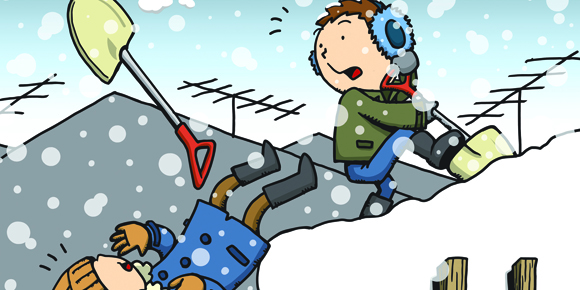Is it better to leave snow on your roof or remove it?
This question has polarized more DIYers than the Trump vs. Clinton clash.
To my humble mind, it is never a good choice to remove snow from a roof unless heat escaping through an inadequately insulated attic is causing water from snow melt to creep under your shingles or other roofing material.
A roof that is built to code with rafters or trusses is designed to support about 30-pounds per square foot (psf) in most areas of Canada.
By comparison, the main floor of a house will support 40-psf or the equivalent of 30 males each weighing 180-pounds, about 5,400 pounds or the weight of an average pick-up truck — that equals a lot of snow.
A common equation used to calculate the amount of snow a 30-psf flat roof will support is 1.25 multiplied by the number of inches of wet snow on the roof. Assuming the snow is 24-inches thick, the flat roof will support 1.25 x 24-inches or 30-psf.
In Manitoba, we average about 50-inches of snow fall a year, much of which is lost to mid-winter thaws and natural evaporation. This means the likelihood of a code-built roof collapsing due to a heavy snow load is close to zero.
Also, keep in mind that most residential roofs are pitched, causing a part of the snow load to be transferred to the walls; therefore, a common 1/3 pitch roof with a 30-psf rating will support around 30-inches of heavy snow without caving in.
The vast majority of the roofs that fail in Manitoba are found on old barns or sheds that were constructed before building codes came into effect. To be fair to the original builders, some of these collapses were caused by neglect of the roofs, allowing spring melt runoff to rot the supporting rafters and weaken their structural integrity.
Reasons for not removing snow from a roof:
• Most homeowners use cheap snow rakes with adjustable, periscopic handles to scrape excess snow from their roofs, with less than adequate results. This DIY technique becomes more arduous and dangerous when a ladder is required as well.
• Once snow has been removed from the lower part of the roof, the homeowner will likely need to climb up on the roof to get at the remaining drifts. If the white stuff is wet, there will be a slick surface under the snow covering the roofing material. Any attempt to walk on this slush is similar to learning how to ride a surfboard; that is, you are guaranteed to fall many times, hopefully not off the roof.
• If you value your bones and perhaps your life, renting an elaborate safety harness to keep you on the roof is highly recommended. It is also advisable to rent some proper metal scaffolding to prevent you from slipping off your ice-covered ladder.
• If you do manage to clear your roof of snow, you may be tempted to do a perfect job by scraping off that underlying layer of slush or thin ice. I know from experience that this is a really dumb thing to do, especially if your roof is covered with asphalt shingles. Your scrapping will remove the coloured mineral that makes your shingles attractive and, most importantly, waterproof.
The first and only time I assiduously removed snow from my roof, I shortened the lifespan of my asphalt shingles by about 10 years. Roofs, no matter what material they are covered with, do not like to be scraped naked.
• Speaking of naked, snow is good insulation. Think about it. If you were living outdoors in a quinzhee, how would you like it if some do-gooder came along and removed all the snow from the roof because he was anxious it might collapse? You’d chase him away with his own snow rake and icy ladder, wouldn’t you?
Reasons for removing snow from a roof:
• I can’t think of a single good reason for scrapping snow off of a roof — unless, as mentioned, you have a problem with snow melt seeping under or through your roofing material. In this case, I recommend hiring a professional to fix the problem.
• By the time you buy a snow rake, invest in a ladder or rent a safety harness and scaffolding and pay hospital bills, it’s cheaper to hire a professional to clear off your roof.
Final word: If you own an 80-year-old house with a well-maintained roof that has no history of collapsing under an unusual snow load, then I suggest your time is better spent relaxing in your favourite recliner, watching your neighbour clear his roof while he is perched three storeys above the ground. It’s a safe way for you to remain on the positive-side of the pole.



